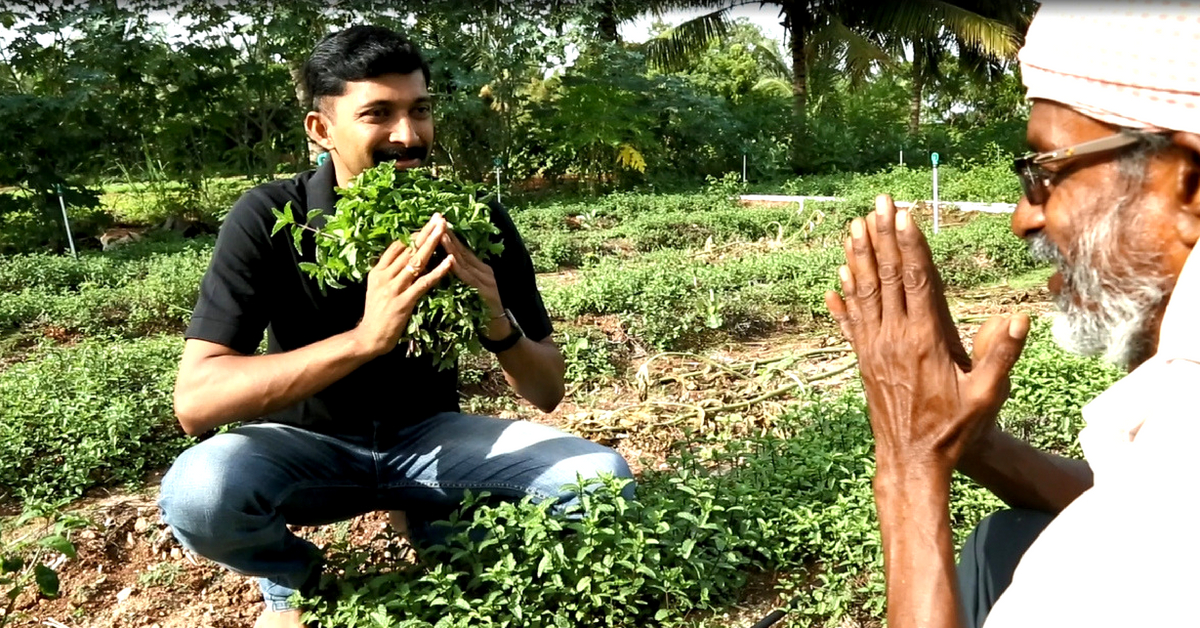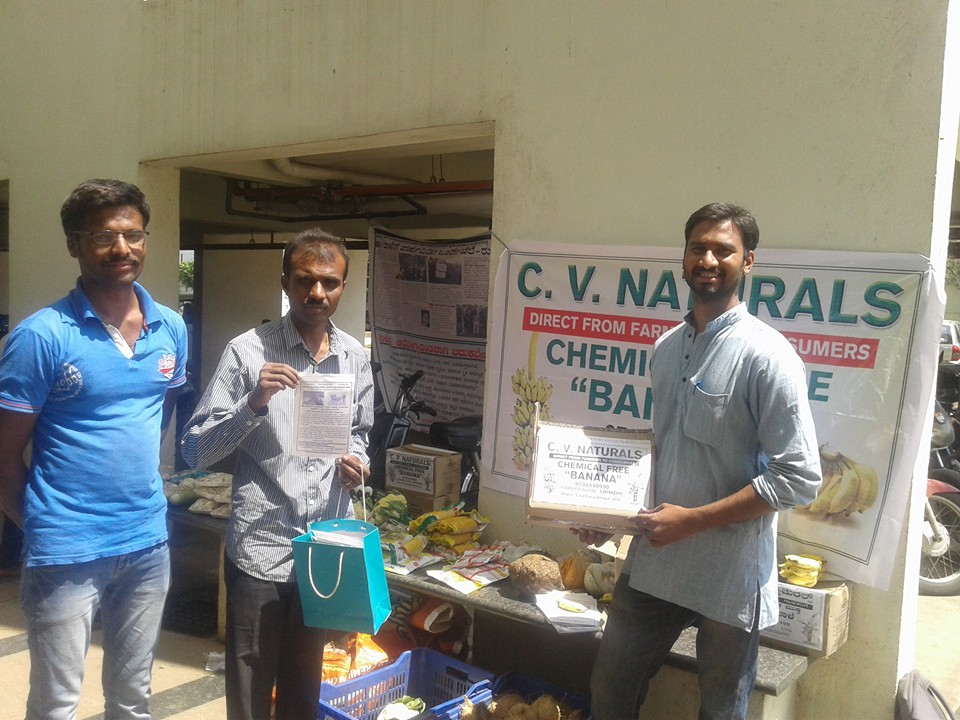Online Keerai to WhatsApp Marketing: 3 Technovations Building Farms of the Future
Innovation is vital, irrespective of which field or sector it has been employed too, and technological interventions are surely what India owes its farmers.

“In the current Indian agricultural scenario, last mile connectivity is a major challenge. This needs to be corrected urgently because extension services are a much-needed requirement for farmers who are the backbone of our country,” says Naveen Kumar, whose revolutionary mobile application, NaPanta, is aiding over a lakh farmers across the country better their crop yield with an all-encompassing agri-encyclopedia.
He adds, “The gaps in the government extension system are occupied by dealers and distributors, or the intermediaries who are present in every corner of India. Because of their commercially-oriented involvement, the farmer bears the maximum brunt in terms of money as well as productivity. This kind of unwanted system has been impacting India’s GDP in quite a drastic manner.
This sector’s contribution to the GDP is roughly about 30 per cent, and this also includes agro-based industries. On its own, the core agriculture industry contributes to about 18 per cent. Imagine how much greater this contribution could be if the last mile connectivity is also achieved!
Digital penetration and smartphone access have played a significant role in helping farmers. Today, close to 90 per cent of farmers are using smartphones or feature phones, and internet charges are much lower compared to earlier days. Even access is quite easy.

So, through the utilisation of these tech-incorporated provisions, it has become possible to reach the end farmers and give them agro-advisory and customised solutions.
Without going the extra mile, tech corporations can help bring down nearly 15 per cent of costs and expenditure that would otherwise be spent by farmers under conventional market norms.
At the same time, proper advisory can enhance 20 per cent of farmer’s productivity, and the distance factor, when sorted, can impact nearly 35 per cent of the profitability, and that too, without the implementation of any form of innovation.”
It is the agriculture sector that primarily drives India’s economy, and despite suffering from poverty, farmers are essentially the cogs in the wheels that feed the nation.
But as Naveen mentions, many roadblocks like last mile connectivity, scientific knowledge, weather appropriate farming practices and farming equipment can be resolved through optimal utilisation of technology in an industry like agriculture.
In recent times, there has been a surge of agri-tech enterprises that play an essential role in helping farmers across the country through a variety of services and provisions.
Innovation is vital, irrespective of which field or sector it has been employed too, and technological interventions are surely what India owes its farmers.
Mobile applications need not be the only intervention when it comes to agri-tech. In recent times, the utilisation of social media platforms like Facebook and Whatsapp by farmers and agri-entrepreneurs to sell their produce and value-added products are becoming more and more prevalent.
So how exactly can such platforms bridge the gap between farmers and consumers?
Sharing insight about social media intervention in the agrarian sector is Chamrajnagar-based engineer turned organic farmer and entrepreneur, CV Srinidhi, whose business model solely rests on Whatsapp and person to person communication.

“The platform is perhaps one of the easiest ways to market any item. Unlike the conventional methods, here, one can directly cater to customers, either through direct messages or broadcast groups. There is ease of communication for not just placing orders but also to coordinate and follow-up on deliveries.
There are so many mobile applications out there today to aid farmers, but I feel that people in rural areas still lack awareness about agri-tech intervention. Even so, one can’t say people are entirely oblivious to the Internet or social media trends as apps like TikTok are quite popular even in the rural side, with almost every household having at least one smartphone.
I do feel that agri-tech interventions, be it mobile apps or marketing through social media, will be picked up soon. If farmers can utilise platforms that guide them through more sustainable farming practices and provide them with useful information about say, crop health or suitable weather conditions, things can significantly change. Awareness over such innovations is crucial, though.
While tech interventions have surely solved my communication and marketing aspects, one area that I’m still struggling with is transportation. Since I personally make door-to-door deliveries, it becomes tiresome and rather expensive. If there were tech-based interventions to resolve this situation, many farmers, including myself, would surely save a lot of money,” he adds.
Like Srinidhi, G Sriram Prasad is also an engineer, who is based out of Coimbatore. However, for his foray into the agri-tech sector, he took the e-commerce route.
Through his venture, Keerai Kadai, where he sells fresh, native greens, Sriram is offering a healthy eating culture to his customers while providing better livelihoods for farmers working with him.
“The agricultural sector has, without a doubt, witnessed a boom in the last few years, and this is not just from the purview of farmers but consumers as well. More and more people are becoming aware of food adulterations and want to know where their food is coming from and how it is grown. But this isn’t possible if they have to buy vegetables or fruits from local markets.
There is also this shift in urban households, and families seldom find the time to head to the market, let alone inspect the greens like our parents used to do.

How does our intervention help? We let our customers pre-order farm fresh greens a day before on our website, like every other e-commerce site. The farmers who work with us receive alerts through Whatsapp, and any one of them who has the necessary supply will accept the order and keep the required harvest-ready by the next day, that is delivered by our staff.
The tech intervention keeps both customers as well as farmers happy, all the while reducing wastage of time, efforts and most importantly, produce. More than consumers, such interventions end up bettering the lives of farmers.
We surveyed the farmers’ expenses and discovered that over 30 per cent of the value of their produce goes into logistics.
In our case, we rule out that expenditure, so that means doubles their savings, while also saving time. Similar tech-based interventions can go a long way in alleviating farmers across the country,” adds Sriram.
Given the digital penetration in almost all sectors across India, the integration of tech-based solutions undoubtedly holds an enormous scope for the agrarian industry. While innovation is central to propel change, the fact that real-time application of the same can only happen if it is accessible and economical needs to be quite seriously considered.
Naveen adds on to this aspect.
“A significant concern one has to keep in mind is that nearly 80 per cent of the farmer population includes small and marginal farmers, who may or may not be adept with technology. So, it is imperative for any innovative idea to add value to farmers’ lives and livelihoods, and you should think about this before heading out to help them with tech-based interventions.
You may also like: This State’s Solutions May Be The Answer Farmers Across India Are Looking For!
For instance, you cannot come up with a fabulous IoT (Internet of Things) device that you feel will alleviate the lives of farmers, but sell it for an exorbitant price. You need to understand the audience you have developed the innovation for and their financial limitations. You need to collect information on these aspects before you start anything.
Think about it, if I am going to develop a big data analytics and my intended users are farmers based in a remote village who have to pay thousands of rupees to avail the services, the intervention serves no purpose here.
So, factors like value addition to the cause, low-cost solutions and swift market penetration are key for agri-tech interventions in India to steer the agrarian economy forward,” he concludes.
It is innovations like these that ATL Tinkering Innovation Marathon aims to develop by giving young innovators a platform to take their ideas to products and help solve issues in different fields from agriculture and infrastructure, to environmental conservation and waste management.
Know more about the ATL Tinkering Innovation Marathon here.

(Edited by Gayatri Mishra)
Like this story? Or have something to share?
Write to us: [email protected]
Connect with us on Facebook and Twitter
This story made me
- 97
- 121
- 89
- 167
Tell Us More
We bring stories straight from the heart of India, to inspire millions and create a wave of impact. Our positive movement is growing bigger everyday, and we would love for you to join it.
Please contribute whatever you can, every little penny helps our team in bringing you more stories that support dreams and spread hope.



















